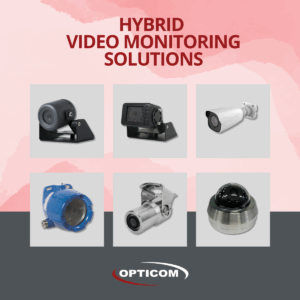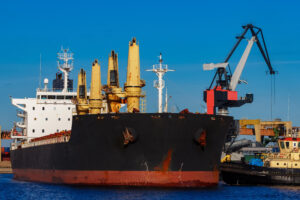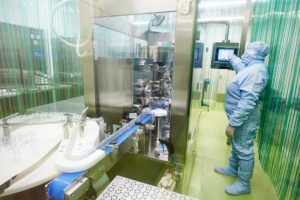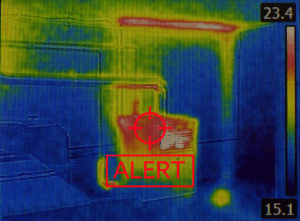Industrial environments are usually harsh, hard to maintain and monitor, as well as expensive to run. This is why, when we talk about video monitoring for industrial environments, most people think about security risks. While those are crucial, there is so much more that video monitoring can do to enhance operations in an industrial environment.
Video monitoring in industrial facilities offers enhanced safety, security, process optimization, compliance, training, and incident analysis. It enables proactive decision-making, helps identify areas for improvement, and contributes to the smooth and efficient functioning of operations.
Let’s take a look at some of the ways Opticom has helped plant managers across the continent streamline their operations through video monitoring.
4 Reasons to Use Video Monitoring for Operations in Industrial Environments
When we recommend a system for industrial operations monitoring, we take extra care to meet specific demands for each industry. For example, humidity may be a big risk to cameras in some plants, while in others, debris and vibrations are constant threats.
Naturally, this means that there are different reasons to monitor your operations for each type of industrial activity. There are, however, a few common reasons our industrial clients cite when they buy a monitoring system from us.
1. Monitor One or More Industrial Facilities Remotely
Supervising a plant is no easy task, especially if we’re talking about a large facility or operations spread over several locations. With video monitoring, operations are monitored any time, from anywhere. On-site operators can watch the feeds in real time for issues and others can check recordings for quality control, safety reviews, and opportunities for improvement.
Industrial environments can be dangerous, and watching operations from a safely distanced monitoring station or from off-site helps keep the workers who are doing the monitoring safe.
By installing cameras in strategic locations, they can monitor critical areas, identify potential hazards, detect unauthorized access, and respond quickly to emergencies. Video surveillance helps prevent accidents, monitor compliance with safety protocols, and deter theft or vandalism.
2. Ensure Compliance and Mitigate Risks and Hazards
Industrial environments can be heavily regulated. Food processing plants, for instance, need to adhere to both federal and state standards and legislation. Legislation is also constantly evolving and facilities have to keep up in order to avoid hefty fines.
Video monitoring helps facilities meet these requirements by providing a verifiable record of operations. It can be used to document adherence to safety protocols, environmental regulations, and quality control procedures, which may be necessary for audits or legal purposes.
Workplace hazards, incidents, and accidents are also fairly common in harsh environments. An improperly used machine can lead to serious accidents, some of them fatal. We know you’re doing everything in your power to ensure the safety and well-being of your employees. Video monitoring systems can help with that, as well as with ensuring compliance.
Oftentimes, faulty assembly lines or improperly used machinery are hard to spot by the people using them, but they can be better spotted by someone in a different vantage point. This is why we work closely with our clients to help them pick the right spots to install the cameras so they can have a clear overview of their facility. In turn, they can spot potential equipment malfunctions or misuse before they turn into regrettable incidents.
3. Maximize Productivity and Streamline Operations
For some plants, even a 1% uptick in productivity can add up to a few million dollars every year. However, just like spotting malfunctions on-site, spotting areas that can be improved upon is hard without a bird’s-eye view of the entire process.
Video monitoring enables real-time observation and analysis of various operational processes. By monitoring workflows and equipment performance, industrial facilities can identify bottlenecks, optimize production lines, and improve overall efficiency. Visual data from cameras can provide valuable insights for process improvement and quality control.
If you’re interested in improving productivity or operations, you can watch the live feed or pull up recorded footage to identify areas that can be improved upon. For extra efficiency, you can use video analytics or have an independent third-party consultant assess your processes and suggest improvements.
4. Proactive Equipment Maintenance
Video monitoring can assist in getting ahead of necessary equipment maintenance. Cameras can watch machinery and equipment to capture their performance, detect abnormalities, and identify signs of wear and tear. By analyzing the video footage, facilities can schedule maintenance and repairs in a timely manner, minimizing downtime and avoiding costly breakdowns.
How to Choose the Right Video Monitoring System for Your Industrial Facility
At Opticom, we know that no two industrial facilities have identical needs. So when we recommend CCTV systems for industrial applications, we always take your specific needs into consideration.
Whether you’re dealing with a humid environment, a high-vibration one, or a debris-filled one, we have the right solution for you—cameras and accessories that can withstand your specific challenges and help you lower your cost of ownership.
Not sure what type of monitoring system is right for your industrial facility? We’ve been helping industrial clients make the right decision for over 50 years. Get in touch with our expert consultants and let’s get your facility fitted with the right industrial-grade cameras.







